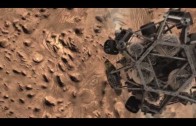Landing will take place the night of August 5th, 1:30 AM eastern, 10:30 pm pacific, and 6:30 AM GMT (August 6th.)
NASA will be streaming live here: http://www.nasa.gov/multimedia/nasatv/index.html
And we’ll be live-tweeting here: http://www.twitter.com/scishow
The Mars Science Laboratory or Curiosity Rover is the largest payload ever delivered to the surface of a planet and it has a terrifyingly complicated descent and landing strategy. First, the atmosphere takes it from 13,000 mph to 2,000 mph. Then a parachute takes it down to 200 mph. The final, powered-descent stage lowers the craft to 21 feet above the surface, at which point it will be lowered by a tether and the rockets will detach and crash land elsewhere.
If the Curiosity survives it’s descent to Mars, it will be the most robust scientific tool to ever explore another planet. The size of a small car, the craft has a planned mission length of two years, during which time it could travel over 12 miles.
Curiosity’s goals are to study the geology and climate of Mars, to determine whether there was once life there, and to prepare for future human exploration of the Red Planet.














